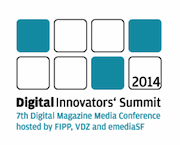Print and digital: striking the balance
The migration of audiences to digital platforms with it's flexibility and "instant" nature as well as rising print and distribution costs and migration of audiences have driven traditional print publishers to digital platforms in their droves. So too advertisers.
US newspaper advertising revenue has declined from nearly $70 billion dollars in 2000 to less than 20 billion last year, according to the Newspaper Association of America – while PwC’s Entertainment & Media Outlook 2013-2017 reveals a challenging future for magazines.
It predicts the US consumer magazine market will be worth $23 billion in 2017, down from $25 billion in 2012. Consumer magazine advertising will fall to $15.2 billion in 2017 from $16.4 billion in 2012, according to the report.
But it’s not all doom and gloom for print. Circulation figures for a number of high-profile publications continue to rise – even if ad revenues are falling. Circulation of the New York Times rose 11.7% last year. In North America, where the recession hit deepest, more new magazines were launched than closed in both 2010 and 2011. And Association of Magazine Media (MPA) in the US says magazine audiences are growing faster than those for TV or newspapers, especially among the young.
And rather than a print versus digital debate, there is sufficient evidence of how print and digital can co-exist, and strengthen each other. This means firms must address how best to build a symbiosis between print and digital – and, specifically, how to best to deliver their established brands digitally.
Digital strategies
David Berkowitz, chief marketing officer at agency MRY, agrees the relationship between print and digital is currently high on the industry’s agenda. “Digital gives people more of what they want. The immediacy factor is critical,” he says. “That, along with the social factor, is changing how people access content.”
Freddie Ossberg is the founder of Raconteur Media, a publishing house and content marketing agency. He says strategies for surfacing print on digital platforms should vary depending on the type and “quality” of the print content.
“We are a provider of premium journalism around niche areas such as business finance, technology, sustainability and other business topics,” he says. “So the value of our content is in the quality of the journalism rather than how it looks in an app or the fact it is interactive. That means there’s less pressure on us to make the content digestible, more interactive or more engaging, for example.
“It’s different for other types of print,” he adds. “There have been some pretty spectacular failings in terms of tablet-only newspapers and magazines, and I think there is an acceptance now that they need to differ across platforms, repurposed for effectiveness.
“In short, print has not died, and content producers are running multi-platform strategies now, where print and digital are operating side by side. As a result, they must not begin with the channel, but with the messaging they want to deliver and to whom. Only then should they think about the channel for delivering that messaging.
“If you think of this from a marketing perspective rather than a reader’s perspective,” he adds, “print and digital must exist in a symbiosis. Digital can be a great way of drawing someone’s interest and, once people are interested, then print can step in and give them the depth and detail they need.”
That’s certainly a view echoed by Stephen Lacy, CEO of Meredith, the US publisher of upbeat women’s service magazines including Better Homes and Gardens, Ladies’ Home Journal, and Traditional Home. Speaking earlier this year about his company deciding to launch a print version of online recipe site allrecipes.com, he said: “What’s different about print is the way the content is curated. Most consumers access allrecipes.com by searching for a recipe they already know they want to prepare. The print magazine will deliver ideas and inspiration readers haven’t yet thought about – and drive them to the website to execute that idea.”
Challenges to change
Ossberg believes that, despite the growing understanding that agencies must adapt content for different platforms, they continue to be hampered by a desire among clients to work the wrong way around.
“One of the challenges we see in terms of content creation for clients is that they think about the execution and the platform before the idea,” he says. “As publishers, journalists and content creators, that is not the correct way. It shows that cost is still a driver for a lot of brands, as they are thinking content on a digital platform is cheaper. If cost wasn’t a problem, they would start with the idea and what they want to achieve, and consider all options.”
Furthermore, the shift to thinking “content first” is being hampered by another industry issue, according to experts. They say a lack of ability among agencies to convince clients that they are a full-service agency rather than a print specialist or a digital specialist suggests those clients are still thinking about print and digital as separate entities – rather than as working in symbiosis.
“What has become clear over the course of moving into the digital space is that it’s hard for us as a traditional content agency to position ourselves as experts in that area,” says Ossberg.
Berkowitz agrees, adding that part of the issue sits with the inability of agencies to adapt their own mindsets. “It’s difficult for any agency to evolve, but it is possible for print agencies to stay ahead of trends and adapt to how people consume content. Granted, if they’ve been doing something the same way for decades and their rival digital shops are nimble enough to shift into new territory with each passing year, the digital shops are going to have more muscle memory for adaption. But it can be done.
Of course, that said, digital has evolved a lot in the past ten years, from offering print outlets complete coverage online to adding new publishing formats like blogs and podcasts, to creating web-exclusive multimedia content, to incorporating social media, to adapting their content to mobile devices. The outlets that are digital natives – having never had to grapple with the legacy print model – are in a better position to adapt faster.”
Tips for transferring your print content to digital
David Hicks, digital magazine creative director, Hearst UK’s App Lab, and who launched the Cosmopolitan and Esquire iPad apps in 2013, offers his top tips (via Twitter) for making digital magazines work.
• Buy the editorial teams some iPads. One device between 18 people will never work
• Simplify the route to access content for loyal print subscribers - fewer than 5 steps
• Encourage editorial teams to create a product that gives more value than a print conversation
• Don't hide content for the sake of a whizzy button. "I want to read it, not search for it."
• It’s not all about tablets. iPhone and smartphones are EQUALLY as important
• Phone editions should not need to follow the iPad or print magazine layout to succeed.
Print distribution innovation
In order to survive, print media has to find a way to reach new readers, find new means of distribution, and reduce the cost of production.
Could the Meganews Magazines newsstand, launched earlier this year, be the answer? The machine, which takes up less than 4 square meters, allows customers to choose the publication they want to buy via a touchscreen, pay with a credit card, and get a copy – printed on the spot – in two minutes. The newsstand is connected to the internet and can download upon request the latest PDF files from any partner publisher's server.
The newsstand is up and running in Stockholm and at launch was offering color prints of 200 magazines and periodicals.





